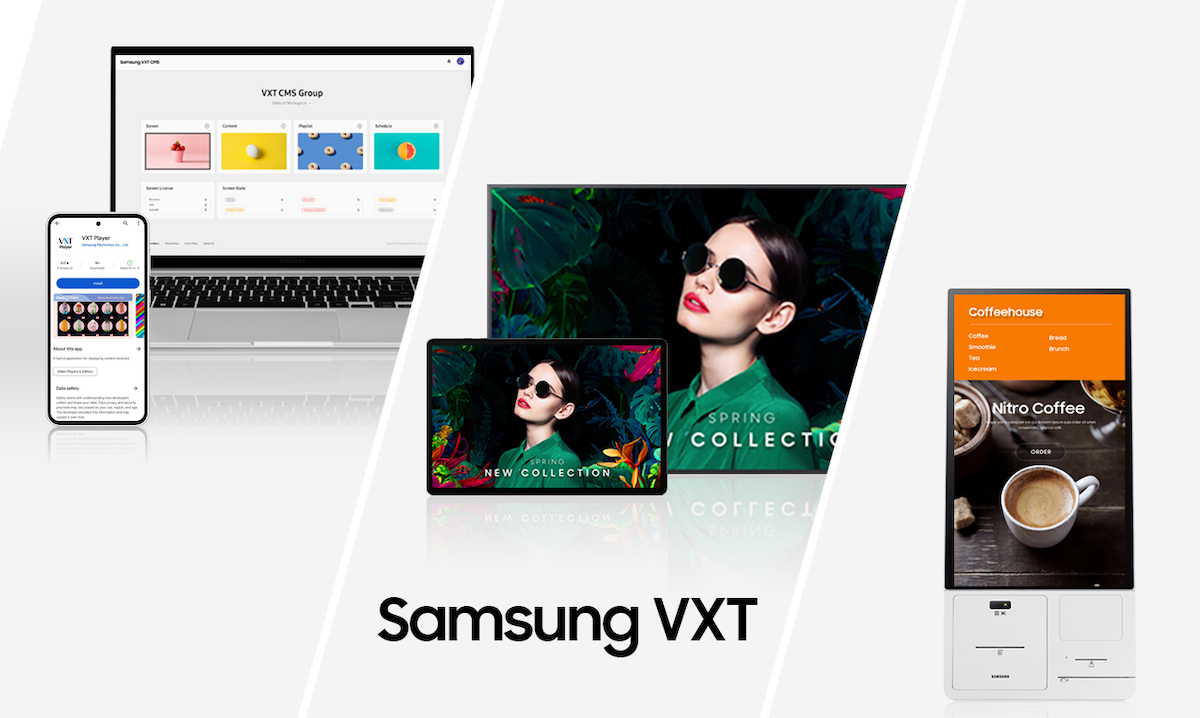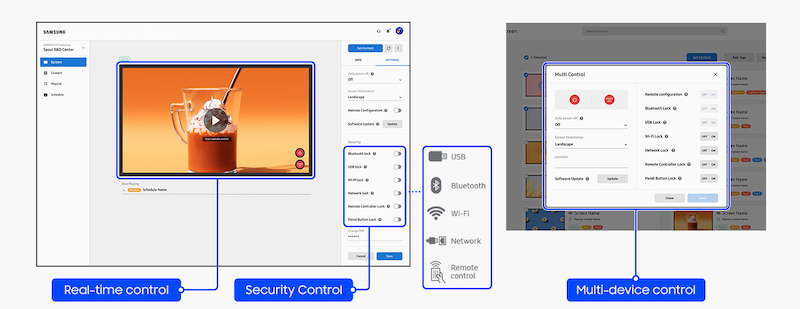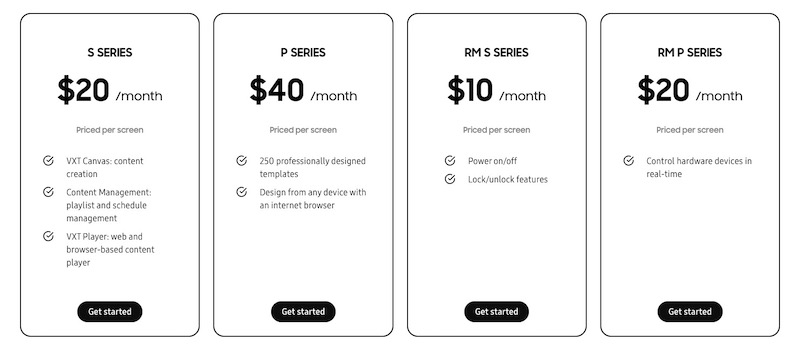
Samsung Eyes Long Tail Of SMB Market For Its Now-Released VXT Digital Signage Platform
February 16, 2024 by Dave Haynes
Samsung has been talking up its VXT digital signage solution for more than a year now, but it was at ISE a couple of weeks ago that the South Korean tech giant formally launched the cloud-based software and services solution to the industry, including the broader pro AV ecosystem.
VXT is short for Visual eXperience Transformation. It is positioned as a modern SaaS platform for content creation and management, bundled with remote device management and even hooked into DOOH ad-sales for cost-recovery. It will soon supplant Samsung’s long-running, legacy software known as MagicINFO.
It is also positioned as something aimed at the so-called long tail – the small to medium business market that lots of CMS software companies start out in, but evolve out of if they can – because single clients with 1,000 software license subscriptions are invariably far easier to manage and support than 1,000 clients with single licenses. In short, SMB customers can be much needier and therefore labor intensive than enterprise customers.
Samsung sees SMB as an under-served market. In many respects, VXT is a more feature-rich and involved version of another software product released by the company in recent years – called Business TV or Pro TV. That software was bundled with prosumer TVs and squarely aimed at small business operators and owners with no time or inclination to learn and use a full CMS. That product was dumbed-down and operated off a smartphone app, so someone like a bar manager could change promo message off her smartphone, without sitting down at a PC.
VXT is also positioned as being dead easy to use – the sort of thing people with little or no technical chops could swiftly learn and use. The UX borrows a lot, and fair enough there, from other friendly digital signage user experiences on the market. One company I chatted with at ISE said they had a look at VXT’s UX and said, “Boy that looks familiar!” They were much more amused than irritated. Emulating user experiences and designs are certainly not unique to big companies.
The concept of headless CMS seems to be at play here – the idea that VXT is the operating and management software foundation, and third party apps could sit on top of that and use what’s already written. So a software company could develop specific functionality for digital signs and run it on top of VXT, with no need for the developer teams to code ALL of the many other underpinning aspects of a full CMS, like device management and security.
That approach could be helpful to all kinds of software companies that have digital signs as a potential output for whatever it is they do, but who don’t want to invest time or heavy resources in developing all the bits needed to drive an an application and software player for screens.

App Functionality On Top Of Software Foundations
At ISE, Samsung had a couple of early-stage partners at its sprawling stand – Ngine Networks for auto and real estate, and Wisar Digital for Point Of Sale integration. Wisar is what Kevin Goldsmith, known in industry circles for building up PingHD, is doing these days. A digital art library, VXT Art, is also in this early-stage apps “store”.
Samsung calls these Pre-Integrated Repeatable Solutions (PIRS), and the idea is that SMB end-users would find them in a VXT online store and subscribe to them in much the way consumers now find streaming content apps, subscribing to and activating apps on smart TVs in homes. Samsung takes an agreed revenue share, just like Apple does off of its own app store.
The intent is that along with subscribing to specific functionality and the core VXT platform (a separate subscription), end-users from the SMB market would also be able to buy a display and, conceivably, other necessary gear like mounting bracketry. People in that market might be most inclined to buy lower-cost TVs and mounts down at the local WalMart, but if the solution stack is right there, some straightforward language warns against using TVs and cheap mounts, and the prices are not wildly different, there is an indisputable attraction to one-stop ordering and delivery.

Market-Priced, Sold Through Channel
The product is being sold through distribution channels like Ingram Micro, but over time it will be more and more direct – certainly, I’d think, when a full online store is spun up.
Pricing in the US market ranges from $20-$40 a month per subscription, which is within industry norms for SaaS CMS software – but on the high side for a SMB market that has a thirst for free or “premium” software. The going rate for that market is probably well less than $10 a node. Device management as add-ons or standalone is $10-$20.
An interesting note – VXT is not pinned to Samsung’s proprietary Tizen operating system, and can work with Android. It is described as device agnostic, though functionality might be a little knee-capped with some devices.
Asking developers to write applications to Tizen OS was always a big ask, and you could see how that stance started wobbling when Samsung added Windows support for its retail kiosks, because of the reticence of manufacturers (like printers) to write driver code for an otherwise fringe OS. A printer, for example, might not work because there were no Tizen drivers, but with Windows …
The VXT player now runs on any device with a Chrome browser, or using the Android APK. Windows support is said to be in development.
What Samsung Says
While at ISE, I had a 45-minute chat with Stephen Choi, the LA-based VP for the North American Display Office of Samsung. He has been directly involved in evolving Samsung from being purely a box-mover in the pro AV industry, and was floating managed services as new revenue streams for Samsung a decade ago. By his own admission, too early.
I asked Choi about the response from CMS software partners who were courted and nurtured as partners, who now see their “partner” coming out with a directly competitive platform.
He made several points:
First, he noted that Samsung is by no means the only display manufacturer with digital signage management software, and it is true most of the display manufacturers have something. I countered that what the other companies market is very much entry-level, or with Philips (PPDS) only about device management. The CMS offerstend to get minimal marketing, and exist mainly for the onesey-twosey jobs where the buyers are balking at additional costs from CMS companies. MagicINFO and VXT are seen, I argued, by many in the industry as genuine alternatives to commercial CMS platforms. LG is a big competitor on the display side, but how many people have even heard of LG SuperSign?
Second, Choice agreed that the SMB market is needy and very hard work, and not a pond many software companies want to fish in … unless they have to. But Samsung has the resources and processes to manage large numbers of SMB accounts, he says, and the stomach for it. From my perspective, a lot of companies have pivoted from SMB to enterprise or specialty verticals, but I still see all kinds of small companies going after SMB. However, I’m not convinced a lot of those small companies will grow and thrive at the $3-$5 a month they might see from subscriptions in that entry-level market. It will get even harder for these small companies to be noticed if Samsung allocates marketing budget and goes to work with VXT.
Third, Choi suggests this is not an us vs them situation. He referenced the Swiss software firm Navori, which does a lot of trade in North America, as an example. “They didn’t like the fact that Samsung still pushed magicINFO. And I respect that. But they also recognized that they could use a portion of what we had in our portfolio – remote management. So they bundle that and resell it to their customers. So we can co-exist.”
Choi concedes the CMS software community would greatly prefer Samsung that stay in its hardware lane, and that some are miffed. “Look, if I was in their shoes, I wouldn’t be impressed either. But I’m saying, ‘Alright, guys, let’s talk.’ Let’s create a win-win situation.”
He suggests, as has been done in earlier discussions about VXT, that CMS software companies could re-market certain functionality that it has developed by making it an app that sits on VXT, and then having it marketed and distributed through Samsung and its channel. “Let’s work together … come work with us and become that integrated solutions provider. You could provide the solution. And then as a community, we could market together.”
I am not sure how that would be received but certainly, there are times when software companies come up with something to close a deal, and that functionality is outside of the norm. I’m thinking things like meeting room displays and queue management. Maybe there’s an argument to market that through an SMB store.
The counter-argument, of course, is that working with Samsung runs the risk of seeing existing clients exposed to VXT – pricing, functionality or whatever – who then move off the third-party CMS platform and go instead with Samsung’s offer. I suspect the Fox In The Henhouse analogy would be used quite a bit with respect to all of this.
Apps Secured Via Core Platform
One of things that intrigued me with VXT was the security angle.
Samsung makes a lot of noise about its high-level security certifications via its security and management framework Knox, and backed up by ISO certifications. So the foundational management and monitoring is secured, but what’s the risk with small companies parking things like e-commerce applications that sit on top of VXT, that might not have anywhere near that level of security?
Choi has a Certified Information Systems Security Professional designation, and says using that third-party app still has to rout through VXT’s security design. So it’s not a risk to end-users.
Disruptive Or Not?
The emergence of VXT has been described as potentially disruptive to the digital signage industry. But if you have been in this industry for a while, all kinds of big companies have come in with big announcements and resources, and then they have more often than not just petered out. HP. DirecTV. Verizon. Even Google, though they’re back and operating much differently.
Samsung is obviously quite a bit different, as the company has been a major player in this ecosystem for 15-plus years, and is the lead or certainly top three display provider in most markets. But Samsung is still, at its core, a manufacturer and marketer of physical products. Those products all tend to have software in them – even home appliances – but this is selling Software as a Service and supporting what could be a legion of needy small accounts who don’t read manuals and don’t want to know how things work. They just need their screens to work. Like now!
The display companies pretty much have to go down this path of they intend to remain in digital signage and pro AV because hardware margins are so thin of displays, and they’re one-time buys. It does not help that the Chinese display manufacturers who in many cases manufactured pro displays then badged as Samsung or LG or whoever, are now directly marketing their own lines pro displays. TCL even has a subsidiary, Moka, selling pro displays with embedded Brightsign players.
Software, by comparison, offers recurring revenues, and the Chinese aren’t coming on that front. And I don’t think there are many Western operators who would use software developed, managed and hosted inside China.
LG, by the way, is once again seemingly shadowing Samsung and started making noise at ISE about something it called LG Business Cloud. It is not something that emulates VXT, and more a portal. I had a meeting about that at ISE, as well, and I would politely say, “It’s early.”
The CMS software companies that invested a lot of resources and time in developing to Samsung’s smart display ecosystem, with the idea that Samsung would do OS and they’d do management software, have reason to be irked by the rise of VXT. But MagicINFO has been around for well more than a decade, and they’ve been at partner events where their own software was showcased, followed by MagicINFO demos that had the CMS guys muttering WTF???
Saw those in person. Not hearsay.
So anyone who’s surprised by Samsung coming directly into their line of business hasn’t been paying attention, or listening to people like Chris Riegel, CEO of STRATACACHE, who was saying 10 years ago that working with Samsung meant working with a company that would eventually be a direct competitor.
I heard, at ISE, some display guys relating stories of software firms coming to them, wanting to talk, because Samsung was now, in essence, dead to them.
But … the software guys aren’t the ones typically specifying what display manufacturers to buy from. What does get specified and ordered for projects has all kinds of contributing factors from unit price to availability and regional support levels. So Brand X CMS can be annoyed with Samsung, but his or her client probably doesn’t care … because it’s not their world, and not their politics.
The bigger question, to me, is whether Samsung is only focused on the SMB market. There are lots of more mature and established CMS companies that would say, “You want to chase all the long tail of three and four license deals, and all the work that goes with that, fill yer boots!”
But would Samsung turn down enterprise opportunities for VXT if they came along? Of course not.
While the talking points for VXT are focused on helping out Ma and Pa-level businesses, the launch press release for VXT specifically references – up high – roll-outs involving all the Hy-Vee’s groceries across the Midwest … a deal that in other Samsung meetings would be referenced as an Enterprise customer.



Dave, oops, I think you meant PRC (People’s Republic of China) and not ROC 😅😊
Oopsie … fixed! Thanks
Dave, your well-written post is packed with useful information! Just a friendly heads-up: when we mention the term ‘Republic of China,’ we’re actually referring to Taiwan, not mainland China. The latter is officially known as the People’s Republic of China (PRC). Cheers!